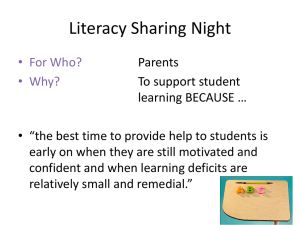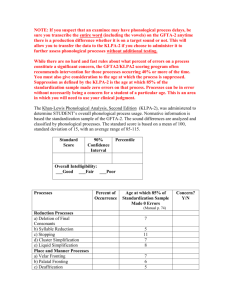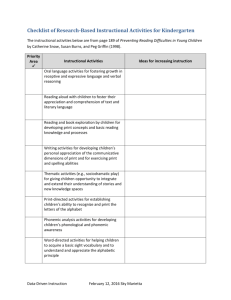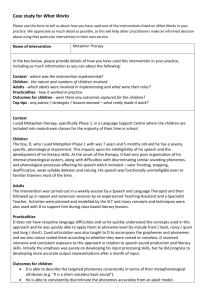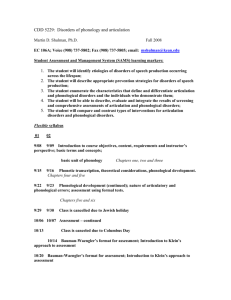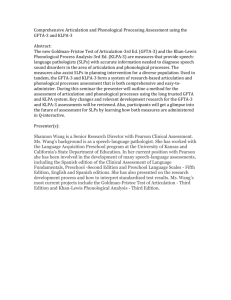Powerpoint Scaffolding Instruction to Build on Childrens Prior PA
advertisement
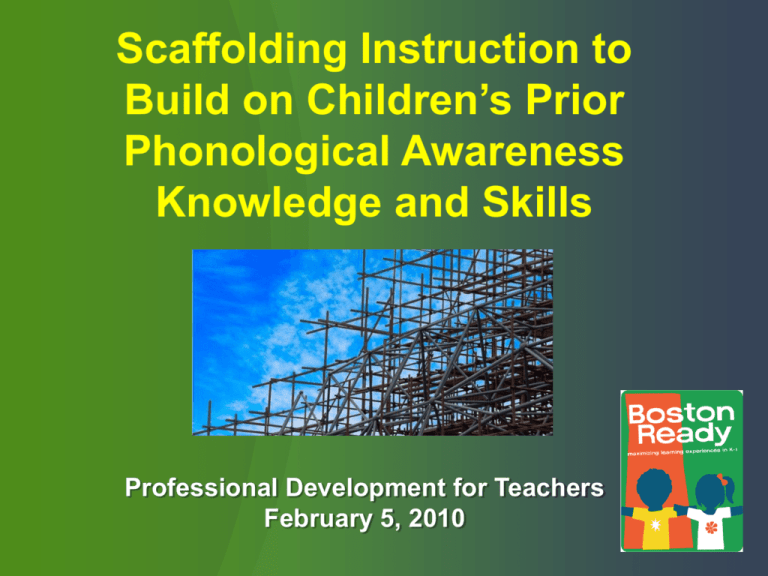
Scaffolding Instruction to Build on Children’s Prior Phonological Awareness Knowledge and Skills Professional Development for Teachers February 5, 2010 Welcome ► If you do not have a name tag please make one. ► Include 2 words to describe yourself. Tanya Shy curious Sharing Work Plan Implementation In two/three minutes, respond to one or two of these prompts: ► How has your Instructional Partner collected data about individual children’s literacy skills? ► Which differentiation strategies have you used? ► How have you differentiated OWL instruction? ► How have you used small groups to support individual children’s learning? ► What “ahas” have you had about Leos and Zoomers? Group Norms ► Be on time ► Respect all opinions ► Listen ► No sidebar conversations ► Turn off cell phones Goals Session goals: 1. Use task analysis to clarify levels of phonological awareness skills. 2. Identify everyday activities to assess and then teach phonological awareness skills. 3. Develop a plan to extend OWL phonological awareness skills to support Leos’ success. 4. Reflect on Zoomers and develop scaffolds for phonemic awareness skills. What do we know about …? ►Use the next fifteen minutes to complete the questionnaire. ►When you are finished, please see one of the facilitators. ►Your responses will be used only as aggregate research data. Break Time Cocoa Tea The Matching Game In your group of 4-5 people, match each teacher Prompt with the phonological term for the skill being taught. 1. What did you notice about the set of prompts you were given? 2. How can you use this information? 3. What should you share about this with your instructional partner? Phonological Awareness is… …the understanding that oral language can be broken up into individual words, words into syllables, and syllables into individual sounds, or phonemes. o Skills include rhyme, syllable-awareness, and phonemic awareness. - Bradley & Bryant, 1983; Snow, Burns, & Griffin, 1998 Reading Letters Phonics Listening Phonemic Awareness Phonological Awareness What does research tell us? Changes in Our Understanding Funding Research New Understanding Linking Early Literacy to Reading Early Literacy Skills Reading First Comprehension Print Awareness Alphabet Knowledge Phonemic Awareness Vocabulary Successful Readers Vocabulary Phonological Awareness Phonics Fluency Phonemic Awareness Is Important ►It supports learning how words are represented in print. ►It allows children to notice the number, identity, and order of sounds in words. ►It is required to understand how to use phonemic cues in identifying printed words. ►Without it, children cannot understand the strategy of “sounding out” words. Why Phonemic Awareness is Important ►Children who are better at detecting and manipulating syllables, rhymes, or phonemes learn to read faster than children who cannot complete these tasks. ►The lack of phonemic awareness is the most powerful determinant of the likelihood of failure to read. ►Phonemic awareness is the most potent predictor of success in learning to read - more highly related to reading than tests of general intelligence, reading readiness, and listening comprehension. Phonological Awareness Deficits Persist ►Children with dyslexia have weak phonological awareness, and have a phonological processing deficit that will persist into adulthood unless directly targeted as part of a comprehensive intervention. ►All children benefit from early phonological awareness training strategies as prevention, but particularly children with weak phonological awareness. Cracking the Code Children with poor phonological processing skills: ►have difficulty “cracking” the alphabetic code. ►tend to rely on contextual cues to guess the unfamiliar word rather than knowledge of phonics to decode it. Phonological Awareness Continuum Phonological Awareness Continuum Alliteration Rhyme Alliteration Producing groups of words that begin with the same initial sound Sentence Segmentation Segmenting sentences into spoken words Syllable Onsets and Rimes Phonemes Blending syllables to say words or segmenting spoken words into syllables Blending or segmenting the initial consonant cluster (onset) and the vowel and consonant sounds spoken after it (rime) Blending phonemes into words, segmenting words into individual phonemes, and manipulating phonemes in spoken words /m/ /ice/ /sh / /ake/ (onset) (rime) /k/ /a/ /t/ /sh/ /i/ /p/ /s/ /t/ /o/ /p/ Alliteration ten tiny tadpoles Examples Rhyme cat, hat, bat, sat Rhyme Matching the ending sounds of words The dog ran away. 1 2 3 4 /mag/ /net/ /pa/ /per/ Strategies to Promote Phonological Awareness ►Choose books to read aloud that focus on sounds, rhyming and alliteration . ►Invite children to make up new verses of familiar words or songs by changing the beginning sounds of words. ►Play games where children isolate the beginning sound in familiar words or generate rhyming words. If you want children to play with language, you have to model it! Build a Rhyme Awareness Repertoire ►Read rhyming stories and poems ►Guess what rhymes with…. ►Fill in the missing rhyme ►Substitute new rhymes for old ►Generate name-and-word pairs Adapted from Gillon, 2004, Hohmann ,2002 Bingo Board Build an Alliteration Repertoire ►Use the term “alliteration” ►Use alliterative phrases in everyday conversation ►Identify alliteration in books, poems, tongue twisters, songs ►Fill in missing alliterations ►Substitute new alliterations for old ►Make up name-based alliterations ►Alliterative “I Spy” Adapted from Hohmann, 2002 Play with Words If you want children to play with language you have to model it.” So have fun with words! ►Record children’s examples of rhyming, alliteration, or nonsense sequences in a classmade big book, and read them aloud over and over! lovely lie licking “To match the right skill with the child, you need to know what each child can do phonologically” How do you know what children know? Using the book, Walter Was Worried, how can you assess what a child knows and what the next steps might be? At your table, divide into 2 groups, one to focus on a Leo and the other to focus on a Zoomer Task 1. How could you use Walter Was Worried to identify a child’s skills? 2. Which specific skills could you teach with this book to the Leo? To the Zoomer? 3. Prepare to report on skills assessed, skills taught, and HOW. 4. As other groups report out, check off items you have listed. Only share ones not already mentioned. Celebrating Boston Ready How will you build your presentation for the Boston Ready Celebration? 1. What information, artifacts could you use to share your Boston Ready experience? 2. How will you best present it? LUNCH Word Chain ►Form a circle. ►Follow the directions of the facilitator. ►Have fun! Scaffolding I do it. We do it. What child can do only with help You do it! What child can now do alone Connecting Poetry and Phonological Skills 1. Break into groups at your table by Leo or Zoomer focus. 2. Read the poem you have been assigned, and identify one skill to teach your Leo or your Zoomer. 3. List teacher prompts to teach that specific skill (refer to the “Phonological Awareness Matching” blue handout). Poetry Phonological Skills Report Out ►What skill did you focus on? ►How did you use the poem? ►What are the specific prompts you used or developed? Focus on Instructional Partners’ Upcoming Professional Development What do you want Instructional Partners to know about building vocabulary through everyday conversations? Work Plans 1. How will you assess and document individual children’s PA skills? 2. How will you extend OWL PA activities for both Leos and Zoomers? What did you learn today? In the Book Bag Wrap Up ►Taking it home ►Sign out ►Tent cards ►Certificates ►Materials

